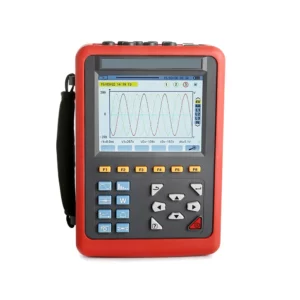Power quality analyzers employ various testing methods to assess and analyze the quality of electrical power in a system.
Here are some common testing methods used by power quality analyzers:
- Voltage and Current Measurement: Power quality analyzers measure voltage and current waveforms to assess their magnitude, frequency, and distortion levels. This includes RMS (root mean square) measurements, peak values, crest factor, and harmonic content.
- Harmonic Analysis: Power quality analyzers perform harmonic analysis to identify and quantify harmonic distortion in voltage and current waveforms. They measure harmonic content, total harmonic distortion (THD), individual harmonic components, and harmonic distortion factor (HDF).
- Transient Analysis: Power quality analyzers capture and analyze transient events, such as voltage sags, swells, spikes, and surges. They measure the duration, magnitude, and frequency of transient disturbances to assess their impact on electrical equipment.
- Flicker Analysis: Power quality analyzers evaluate voltage flicker or fluctuation, which can cause visual discomfort or equipment malfunction. They measure parameters such as short-term flicker (Pst) and long-term flicker (Plt) to assess flicker severity.
- Voltage Unbalance Analysis: Power quality analyzers analyze voltage unbalance, which occurs when the voltage levels of three-phase systems are unequal. They measure voltage unbalance ratios and phase angle differences to identify and diagnose unbalanced conditions.
- Power Factor Measurement: Power quality analyzers measure power factor to assess the efficiency of electrical power utilization. They calculate leading or lagging power factor values and provide insights into reactive power consumption.
- Frequency Analysis: Power quality analyzers monitor the frequency of electrical power to ensure it remains within acceptable limits. They measure frequency deviations from the nominal value and assess frequency stability over time.
- Voltage Dip and Interruption Analysis: Power quality analyzers detect and analyze voltage dips (short-duration voltage reductions) and interruptions (complete loss of voltage). They measure the duration, depth, and frequency of these events to evaluate system reliability.
- Inrush Current Measurement: Power quality analyzers measure inrush currents that occur when electrical equipment is energized, such as motors or transformers. They assess the magnitude and duration of inrush currents to ensure proper equipment operation.
- Waveform Capture and Recording: Power quality analyzers capture and record voltage and current waveforms during transient events or abnormal conditions. This waveform data can be analyzed later to diagnose power quality issues and troubleshoot system problems.
These testing methods enable power quality analyzers to identify and diagnose a wide range of power quality problems, helping to improve the reliability, efficiency, and safety of electrical systems.
How does a electric power meter evaluate the dielectric strength of a circuit breaker?
Electric power meters are not typically designed to directly evaluate the dielectric strength of a circuit breaker. Instead, the dielectric strength of a circuit breaker is typically evaluated using specialized testing equipment called insulation resistance testers or hipot testers.
Insulation resistance testers apply a high voltage (often significantly higher than the normal operating voltage of the circuit) between the conductive parts of the circuit breaker and its enclosure or ground. By measuring the resulting current flow, the tester can determine the insulation resistance of the circuit breaker. This measurement helps assess the ability of the insulation materials within the circuit breaker to withstand high voltages without breaking down.
Hipot testers, or high potential testers, are similar but typically apply an even higher voltage to the circuit under test. They are used to perform a dielectric strength test, also known as a hipot test or high potential test. During this test, a high voltage is applied between the conductive parts of the circuit breaker and its enclosure or ground for a specified duration. The tester measures the leakage current during this test to ensure it remains within acceptable limits. If the leakage current exceeds the specified threshold, it indicates a potential insulation breakdown or weakness.
Both insulation resistance testers and hipot testers are essential tools for evaluating the dielectric strength of electrical components such as circuit breakers. These tests help ensure the safety and reliability of electrical systems by identifying insulation faults or weaknesses that could lead to electrical failures or hazards.
